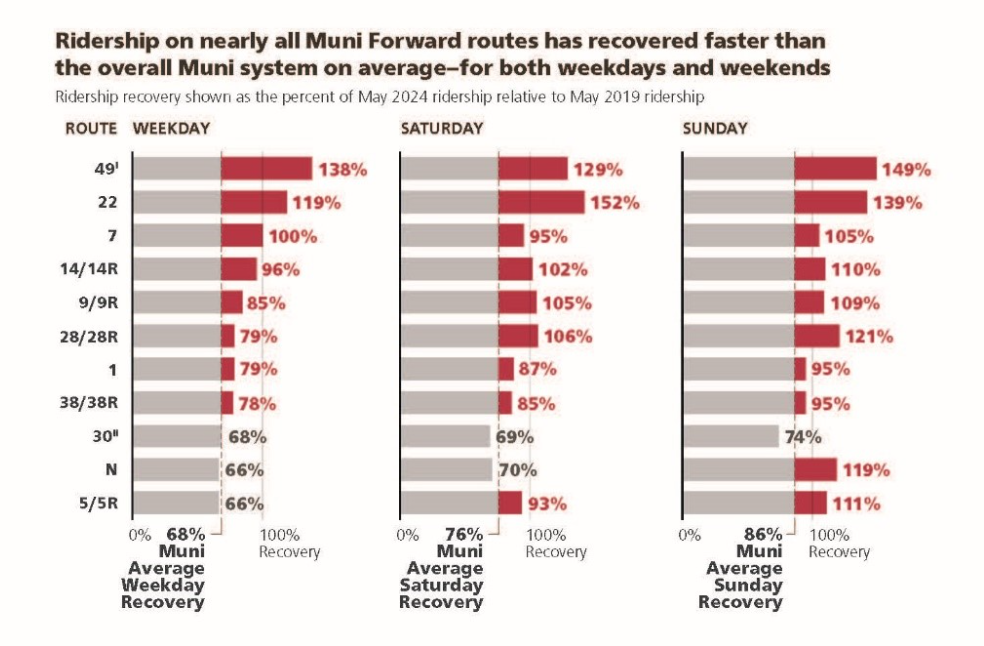
The 9R San Bruno Rapid cruising down its dedicated transit lane, speeding up commutes for thousands of riders every day.
This year, we’re celebrating 10 years of Muni Forward, an SFMTA program that aims to make public transit in the city faster, more frequent and reliable and safer.
Since it started in 2014, Muni Forward has made big changes to help hundreds of thousands of people move around San Francisco every day. The city now has over 75 miles of transit lanes. That’s the most per-capita of any large U.S. city!
We’ve improved routes and made the places where people board Muni safer. All these changes are designed to help make your ride on Muni quicker and more reliable.
We’re excited to share our report, “Fast Forward: 10 Years of Muni Forward, 2014-2024.” It shows important data, achievements and how these changes have helped San Francisco's neighborhoods.
Our goal is to show how we have transformed public transit in our city by:
- Partnering with a range of stakeholders
- Making continuous improvements
- Piloting innovating projects
Join us as we look back at a decade of progress and think about what’s next for Muni Forward in San Francisco.
Building a better transit system: Muni Forward's impact
Over the past decade, Muni Forward has made significant upgrades to San Francisco's busiest transit corridors, covering more than 100 miles. These upgrades aim to make travel faster, more frequent, reliable, safe and accessible. Key initiatives include:
- Introduction of red transit lanes
- Upgraded bus stops and traffic signals
- New Rapid bus routes on major corridors
- Updated bus routes for better neighborhood connectivity
- Enhanced accessibility features
These data-driven enhancements have yielded impressive results:
- Up to 35% faster travel times on improved routes
- Over 50% reduction in injuries on several streets
- 23% increase in ridership on Rapid Network routes before the pandemic (2015-2019)
- Strong post-pandemic ridership where we’ve made improvements, with routes like the 14 Mission/14R Mission Rapid at 96% of pre-pandemic ridership and the 49 Van Ness/Mission exceeding pre-pandemic levels at 138%
- Record-high 72% rider satisfaction in 2024
These upgrades have positively impacted lines serving 93% of all Muni riders.

Riders are returning faster to Muni Forward routes than the rest of the system—on both weekdays and weekends. See how May 2024 ridership stacks up against May 2019 levels. For an accessible version of the chart, visit this webpage.
Real impact on San Francisco streets
14 Mission/14R Mission Rapid Transformation: Changes to the 14 Mission corridor are one example of how Muni Forward is working to improve travel time, reliability and safety. Improvements like new bus lanes, better traffic signals and safer streets have resulted in:
- 9% faster travel times across the entire local line
- Up to 31% faster travel times in the SoMa area
- 59% fewer crashes on Mission Street in the Mission District
Temporary Emergency Transit Lanes (TETL) Program: The TETL program is as an example of our quick-build approach. During the COVID-19 pandemic, Muni Forward quickly added over 15 miles of new transit lanes in just two years. This led to:
- Up to 31% reduction in transit travel times
- Strong community support, with many people wanting to make these changes permanent
Safety and Vision Zero: Muni Forward supports San Francisco’s goal of Vision Zero, which aims to eliminate traffic deaths. Our improvements have helped make streets safer, with fewer crashes and injuries.
Saving Money While Improving Service: By making buses and trains move faster, Muni Forward has also saved money. We’ve saved an estimated $5-10 million per year in operating costs compared to what it would take to operate today’s service without these improvements.
What’s next for Muni Forward?
Muni Forward isn’t stopping here. We’re building and planning more improvements to keep making transit better for everyone:
Approved projects in Mid-Construction:
Projects in the Planning Phase:
- 1 California Muni Forward
- 22 Fillmore: Fillmore Street Muni Forward
- T Third reliability improvements
- Top 10 Transit Delay Hot Spots
Future plans
Muni Forward
- We will keep focusing on neighborhoods from the Muni Service Equity Strategy and on routes with the most riders.
- In the future, we’ll continue to work to make trips faster. This will get you where you’re going sooner and reduce the cost of providing service.
- We’ll use better technology for traffic signals and enforcement of transit lanes to save both time and money.
Five-Minute Network
This is our vision to create a subway-style experience for people traveling on Muni's busiest bus and street-level train lines. We'll be rolling out even greater transit priority for these lines. Our goal: build a network where vehicles only stop at transit stops, just like a subway train. Though this is a long-term project, we’re starting by improving key routes now and working toward a five-minute wait time on more routes as funding allows.

SFMTA workers put the finishing touches on a new transit lane on Van Ness Avenue, paving the way for faster, smoother rides.
Looking to the future
Over the past decade, Muni Forward has transformed San Francisco’s public transit system. These upgrades have made it faster, safer and more frequent and reliable. As we celebrate this milestone, we remain focused on making more improvements to meet the needs of our diverse and dynamic city.
Stay tuned for more updates and insights from our "Fast Forward: 10 Years of Muni Forward" report. Let’s keep moving San Francisco forward together!